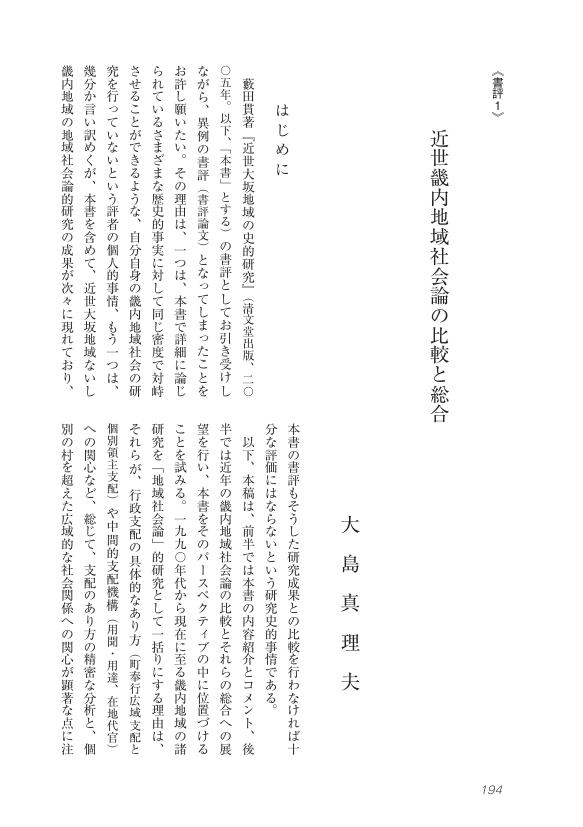70 0 0 0 「士農工商」論ノート
- 著者
- 大島 真理夫
- 出版者
- 大阪経済大学
- 雑誌
- 經濟史研究 (ISSN:1344803X)
- 巻号頁・発行日
- vol.2, pp.131-144, 1998-03-30
5 0 0 0 OA 日本経済史研究の視角と方法
- 著者
- 大島 真理夫
- 出版者
- 大阪経済大学日本経済史研究所
- 雑誌
- 経済史研究 (ISSN:1344803X)
- 巻号頁・発行日
- vol.25, pp.1-30, 2022-01-31 (Released:2022-03-11)
1 0 0 0 OA 原田敏丸先生の農村史研究と私
- 著者
- 大島 真理夫
- 出版者
- 大阪経済大学日本経済史研究所
- 雑誌
- 経済史研究 (ISSN:1344803X)
- 巻号頁・発行日
- vol.25, pp.203-208, 2022-01-31 (Released:2022-03-11)
1 0 0 0 OA 山崎隆三の学問を振り返る 山崎史学私論
- 著者
- 大島 真理夫
- 出版者
- 大阪経済大学日本経済史研究所
- 雑誌
- 経済史研究 (ISSN:1344803X)
- 巻号頁・発行日
- vol.15, pp.177-196, 2012-01-20 (Released:2018-10-01)
1 0 0 0 OA 経済史における勤勉革命論の射程 地域の個性を把握する方法
- 著者
- 大島 真理夫
- 出版者
- 大阪経済大学日本経済史研究所
- 雑誌
- 経済史研究 (ISSN:1344803X)
- 巻号頁・発行日
- vol.15, pp.1-34, 2012-01-20 (Released:2018-10-01)
1 0 0 0 OA 斎藤修著『比較経済発展論―歴史的アプローチ―』
- 著者
- 大島 真理夫
- 出版者
- 大阪経済大学日本経済史研究所
- 雑誌
- 経済史研究 (ISSN:1344803X)
- 巻号頁・発行日
- vol.13, pp.163-173, 2010-02-20 (Released:2018-11-01)
1 0 0 0 OA 近世日本農家の主体均衡について 友部著の書評として
- 著者
- 大島 真理夫
- 出版者
- 大阪経済大学日本経済史研究所
- 雑誌
- 経済史研究 (ISSN:1344803X)
- 巻号頁・発行日
- vol.12, pp.240-249, 2009-02-10 (Released:2018-11-01)
1 0 0 0 OA 近世畿内地域社会論の比較と総合
- 著者
- 大島 真理夫
- 出版者
- 大阪経済大学日本経済史研究所
- 雑誌
- 経済史研究 (ISSN:1344803X)
- 巻号頁・発行日
- vol.11, pp.194-211, 2008-03-20 (Released:2018-12-01)
1 0 0 0 OA 秀村選三著『幕末期薩摩藩の農業と社会―大隅国高山郷士守屋家をめぐって』
- 著者
- 大島 真理夫
- 出版者
- 大阪経済大学日本経済史研究所
- 雑誌
- 経済史研究 (ISSN:1344803X)
- 巻号頁・発行日
- vol.10, pp.215-228, 2006-12-20 (Released:2018-12-01)
1 0 0 0 OA 「士農工商」論ノート
- 著者
- 大島 真理夫
- 出版者
- 大阪経済大学日本経済史研究所
- 雑誌
- 経済史研究 (ISSN:1344803X)
- 巻号頁・発行日
- vol.2, pp.131-144, 1998-03-30 (Released:2019-03-01)
1 0 0 0 山崎隆三の学問を振り返る:山崎史学私論
- 著者
- 大島 真理夫
- 出版者
- 大阪経済大学日本経済史研究所
- 雑誌
- 経済史研究 (ISSN:1344803X)
- 巻号頁・発行日
- vol.15, pp.177-196, 2012
- 著者
- 大島 真理夫
- 出版者
- 社会経済史学会
- 雑誌
- 社会経済史学 (ISSN:00380113)
- 巻号頁・発行日
- vol.71, no.1, pp.61-78, 2005
- 参考文献数
- 33
The 73rd annual meeting of the Socio-Economic History Society was held at Osaka City University on May 29 and 30, 2004. The general session was organized by Mario OSHIMA under the title shown above. The speakers took different approaches from those adopted in Japan so far to describe early modern economic history. They focused their views on the scarcity of land used for agriculture as a factor existing nearly everywhere in the world during this era. Industrious revolution, the term coined by Akira HAYAMI three decades ago, can be understood as farmers' efforts to overcome this resource constraint in rural Japan during the 18th and 19th centuries. Atsushi AOKI presented detailed research on four-character words representing land scarcity in formal Chinese histories and agricultural advisory documents issued by local governments, finding the constraint intensified already in the 11th and 12th centuries. Akihiko ETO presented evidence showing that 17th-century Japan still had land available for rice cultivation, which was much needed because of the big spurt of castle-town construction and the development of silver/gold mines aimed at obtaining foreign exchange; however, the country faced resource constraints during the latter half of the century. Takashi IIDA, basing his detailed study on Mark Brandenburg, pointed out that the sharp division between the full farmer class and cottagers in 18th-century eastern Elbe, Germany, intensified as population and agricultural production grew. Tsuneyuki DOHI and Atsuko OHASHI presented comments from the Russian and East Asian perspectives, respectively.
- 著者
- 大島 真理夫
- 出版者
- 社会経済史学会
- 雑誌
- 社会経済史学 (ISSN:00380113)
- 巻号頁・発行日
- vol.77, no.4, pp.609-611, 2012
1 0 0 0 経済史における勤勉革命論の射程:地域の個性を把握する方法
- 著者
- 大島 真理夫
- 出版者
- 大阪経済大学日本経済史研究所
- 雑誌
- 経済史研究 (ISSN:1344803X)
- 巻号頁・発行日
- vol.15, pp.1-34, 2012
- 著者
- 大島 真理夫
- 出版者
- 大阪市立大学経済学会
- 雑誌
- 大阪市立大学経済学会經濟學雜誌 = Journal of economics (ISSN:04516281)
- 巻号頁・発行日
- vol.116, no.4, pp.111-129, 2016-03
- 著者
- 大島 真理夫
- 出版者
- 大阪歴史学会
- 雑誌
- ヒストリア = Historia : journal of Osaka Historical Association (ISSN:04392787)
- 巻号頁・発行日
- no.244, pp.85-92, 2014-06








